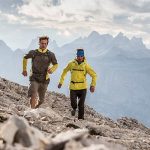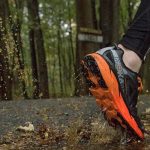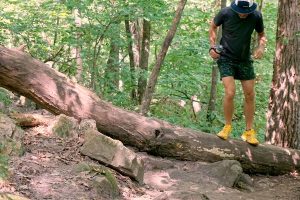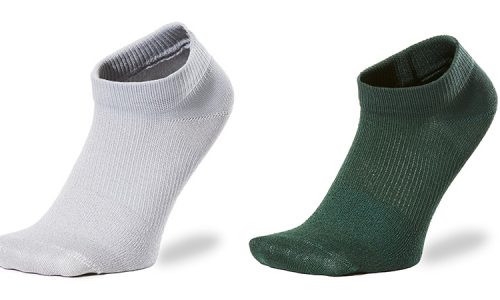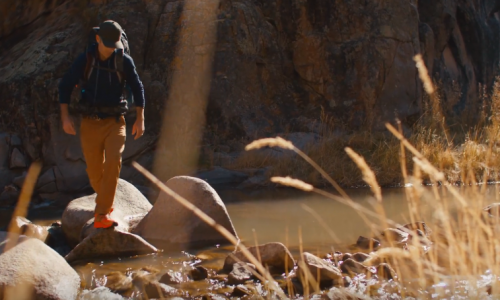Home » Gear Reviews » Running » Running Shoes » Trail Running Shoes » Cushioned & Protective Trail Running Shoes » Asics Gel-FujiRado
Asics Gel-FujiRado Review
August 29, 2017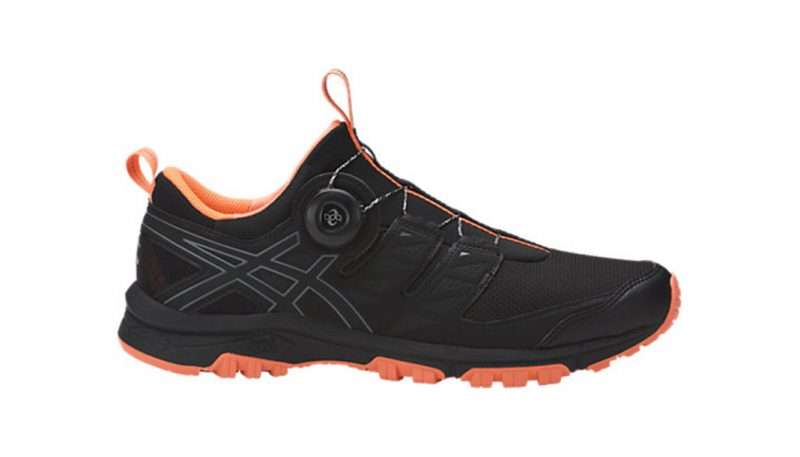
 84
84 The Good
- Smooth lacing system
- Inner bootie
- Supportive upper
- Durable outsole
The Bad
- Narrow midfoot
- Rigid heel
- Firm midsole
- Heavy
The new Asics Gel-FujiRado comes with substantial improvements to the fit and function of the previous model, including two distinctive upgrades: a stretchy inner bootie and a micro-adjustable BOA lacing system. Despite upgrades, the FujiRado’s performance is middle-of-the-road and it’s more of an all-around off-road shoe than a high performer in any single type of trail.
The new Gel-FujiRado (presumably named after a combination of “Mount Fuji” and “Colorado”) replaces the Gel-FujiAttack 5 as Asics’ flagship trail shoe. Many of its features and design choices are unsurprising for a multi-use trail shoe. It’s built on a neutral platform with 23mm/15mm stack height (8mm heel-to-toe drop) with 3mm multi-shaped lugs on the full-coverage outsole. Two features, however, make the FujiRado stand out from the field (and certainly from Asics’ uninspiring line of other shoes). One is the full-length inner bootie, which Asics calls a mono-sock. The other is the micro-adjust BOA tension lacing system, which Asics uses on the FujiRado in lieu of traditional shoelaces. Wear-testers praised both of these features, and felt like they elevated what could have been just another generic trail running shoe. Our test team expressed concerns, however, about the FujiRado’s narrow fit, rigid heel, and excessively firm midsole. Ultimately, despite some innovative and distinctive features, the FujiRado is held back by issues that may be deal-breakers for some runners. As one tester put it, “I love the way this shoe looks and I like Asics’ willingness to innovate, but out on the trail, it just doesn’t live up to my expectations.”
Comfort
One wear-tester gave the FujiRado the ultimate compliment about comfort with a note that, “this may be the only trail shoe I’ve ever considered wearing sockless.” That’s thanks to the smooth, stretchy “mono-sock” inner bootie. With pull-tabs on the front and rear, it’s easy to stretch the bootie enough to slip in a foot. The mid-height front of the bootie gives the FujiRado a really distinctive shape, and our wear-testers didn’t report any extra rubbing or friction on the front of the ankle. The mono-sock is not a single piece, however, and there are a number of seams inside the uppers. None of our wear-testers experienced discomfort or blisters from them, although no one reported actually wearing the FujiRados sockless either.
Speed
The FujiRado’s firm midsole made it feel like a fast shoe on the trail and the flexible forefoot encouraged quick footstrike with efficient turnover. Asics uses a proprietary midsole material called SpEVA, which it claims is a lighter, more flexible version of traditional EVA foam. Some wear-testers felt that the midsole was too firm for a shoe of this weight (10.7 oz for men’s size 9), and in this category, because their legs took a pounding after 12-15 miles on the trail. The 3mm lugs were small enough that some wear-testers lost speed through wet and technical sections of trail, although the small size made the FujiRado feel quick on hardpack and fire roads. The lugs are C-shaped and oriented so that the outsole bites on both climbs and descents.
Security of Fit
The FujiRado shines here. The mono-sock bootie cradles the foot, while an outer cage of more structured material wraps around the instep and lateral side. The result is an upper that feels supportive and secure, but still comfortable. On top of that, the innovative BOA TX4 lacing system is like a bonus feature. Instead of traditional shoelaces, the FujiRado licenses technology from BOA, which got its start making closures for snowboarding and skiing equipment. The BOA system has three parts: a dial to adjust tension, a low-friction lace cable, and lace guides built into the uppers of the shoe. With an easy, on-the-fly turn, the dial pulls in the laces about 1mm per click. It also pops up to quickly release all the lace tension at once. Our wear-testers didn’t report any problems with the laces becoming tangled or releasing haphazardly. However, the micro-adjustment only works in one direction: tighter. Runners can quickly snug the laces down, but the only option to loosen the BOA TX4 is pulling out the dial for full release, then ratcheting it back down to the desired tightness. Additionally, while the BOA lacing system is innovative and works well, runners who use special types of lacing patterns to solve fit issues (heel lock or open forefoot, for example), won’t be able to do so with this system.
Agility
The FujiRado is a middle-of-the-road trail shoe in many ways, including agility. At 10.7oz (for men’s size 9), it isn’t terribly heavy or lightweight. With 3mm lugs that run heel to toe and edge to edge, it isn’t designed specifically for either soft ground or hardpack. Overall, the FujiRado doesn’t feel particularly agile on any one type of terrain, although our runners report that it performs adequately on a range of trails.
Responsiveness
Likewise, the FujiRado doesn’t feel particularly responsive or particularly sluggish—just unexceptional and average. The firm midsole might feel more responsive paired with a lightweight 9oz platform designed for short trail races, but on a 10.7oz shoe, it just feels slightly out of place. The gel insert in the heel is intended to generate a lively, responsive feel, but it’s almost unnoticeable when surrounded by such firm foam.
Protection
The FujiRado does not have a rock plate (although some runners may assume it does after feeling how firm the midsole is), and sharp trail obstacles are noticeable through the sole. The stitched overlay toe bumper works well without being obstructive or feeling constrictive, and the midfoot overlays also protect the foot inside the upper. Although not waterproof, the closed-mesh toe box and mono-sock bootie do a fine job preventing some water and most trail dust from intruding into the interiors of the shoes.
Jason is a trail runner and ultra-marathoner who lives with his wife and children in the frozen tundra of northeastern Wisconsin.










